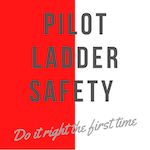Every pilot ladder should have certain markings and certificates to go along with it. Let’s have a look at a random pilot ladder on board and the paperwork that belongs to it:
SOLAS 2.4. All pilot ladders used for pilot transfer shall be clearly identified with tags or other permanent marking so as to enable identification of each appliance for the purposes of survey, inspection and record keeping. A record shall be kept on the ship as to the date the identified ladder is placed into service and any repairs effected.
For this example we use the guidelines ISO 799-1:2019 to explain the various Markings and notations. Every pilot ladder should have a serial number marked as per ISO-799 section 8 as follows: The bottom of the top step and bottom of the lowest spreader step of the ladder shall be marked with:
- The name and the address of the manufacturer
- The Manufacturer’s model designation
- “ISO 799-1” and “SOLAS”
- the year of assembly or reassembly of the ladder
- identification of the approved maritime safety administration, along with any approval indications required by that administration
- where used, identification of an approved organization acting on behalf of the maritime safety administration.
- If a replacement step is used, the words “REPLACEMENT STEP ONLY” shall be used as well.
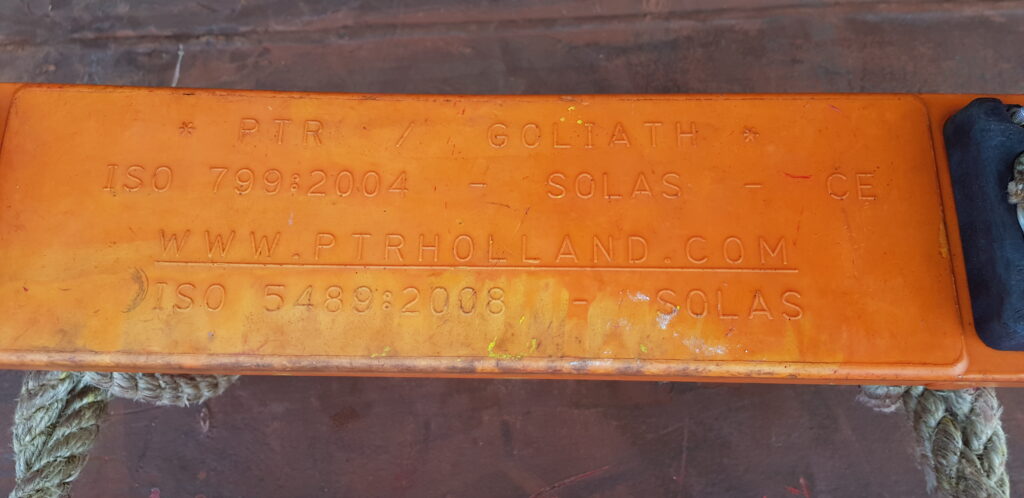
This is for instance a PTR Goliath ladder marked with all of the above items, except for the fact that ISO 799:2004 is still mentioned. This standard has now been replaced by ISO-799-1:2019
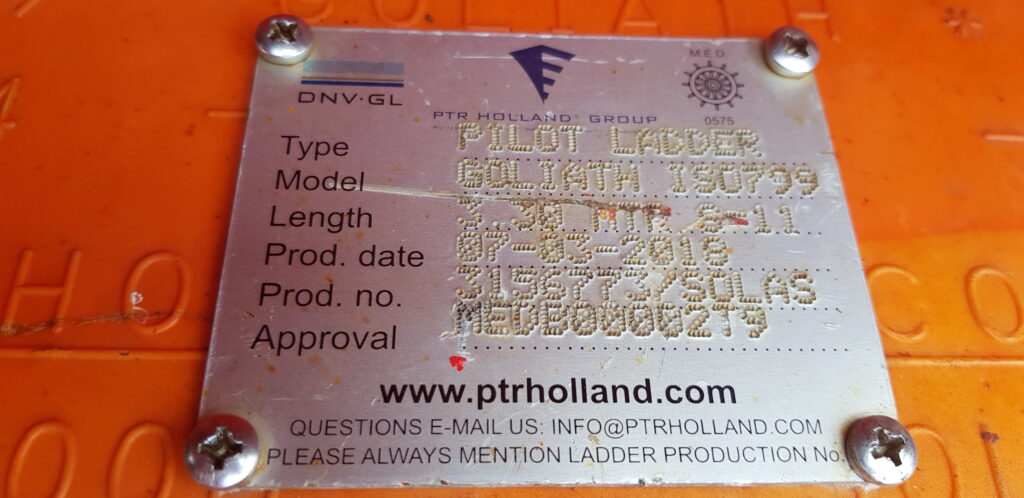
The name tag plate on this ladder displays a few important items that can be cross referenced with the certificate: Type, Model, Length, Production date, as well as the serial number (Prod.No) and the approval standard.
There are 3 logo’s on the top of this plate, which are important in this respect:
- The DNV-GL logo, the classification society that type approves this ladder, as well as the Manufacturing Company.
- The PTR Holland logo, which is the logo of the Manufacturing Company
- The Steering wheel, marked with MED, as well as the number 0575. The symbol and “MED” stands for Marine Equipment Directive 4.49, the EU mandatory regulation* for pilot ladders for all EU flagged vessels. The number indicates the EU designated number of the “Notified Body” which is DNV GL in this case.
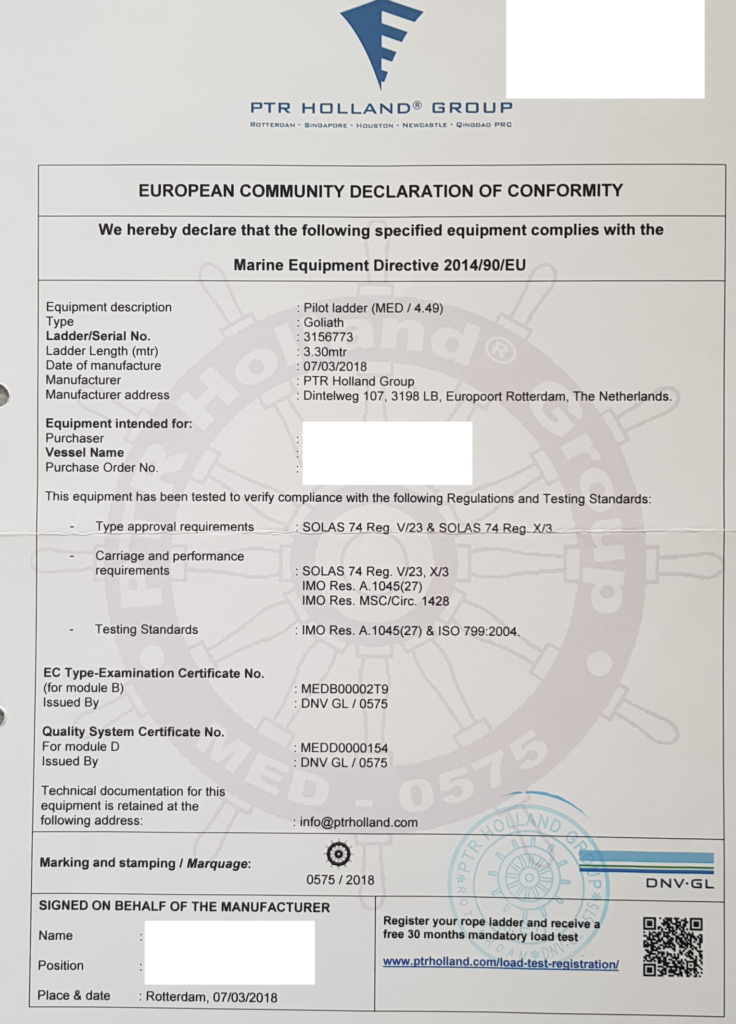
The certificate that goes along with this ladder shows the following items:
- Statement that the ladder complies with MED 2014/90/EU
- Description: Type of equipment, and the MED category (4.49)
- Type: Manufacturers Type “Goliath”
- Serial No. “3156773” ( Corresponding with the serial number on the ladder)
- Ladder Length(m) ( Corresponding with the length on the ladder)
- Date of manufacture: 07/03/2018. ( Corresponding with the date on the ladder) **
- Manufacturer: ( Corresponding with the manufacturer on the ladder)
- Manufacturer Adress
- Vessel name
- The standards, resolutions and regulations to which the ladder complies: In this case ISO-799, Solas and IMO res 1045(27)
- The EC-Type-Examination certificate issued for this type of ladder: in this case its number is MEDB00002T9 ( Corresponding with the number on the ladder) , issued by DNV GL (number 0575). This certificate goes by the name of : “EC-Type Examination Certificate (Module B)”. ( The manufacturer of this ladder also issues a copy of this document with the ladder)
- The Quality System Certificate No. is the certificate issued by classification society DNV GL about the Quality System of the Manufacturer. This certificate goes by the name of : “QS-Certificate of Assessment – EC (Module D)”. ( The manufacturer of this ladder also issues a copy of this document with the ladder)
- The Steering Wheel symbol of MED 4.49: same as on the ladder (see above)
- The Logo of the classification society.
- The signature on behalf of the manufacturer
- Registration QR code: The manufacturer of these ladders uses blockchain technology to keep track of the ladders produced. On the latest ladders, the steel plate on the ladder also shows the same QR code. This allows inspectors to easily scan the pilot ladder and check online if all specifications are correct. ( see below)
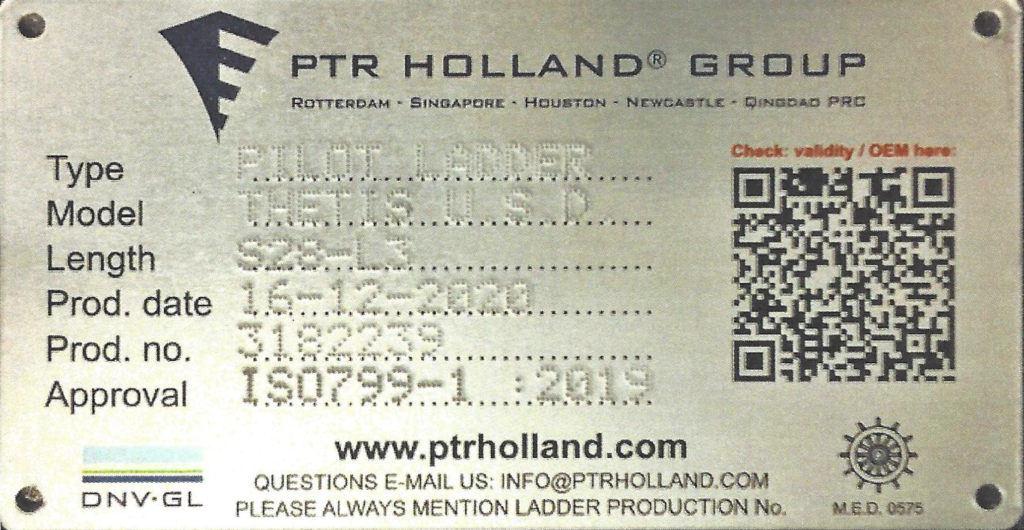
** In this case the ladder is over 30 months old, and therefore a certificate of load testing should be present as well.
Apart from this certificate, there should be a record of repairs, and a record of maintenance of the pilot ladders onboard.
Something is not right here: A fake certificate
The following ladder was presented in december 2020, when the pilot boarded a vessel:
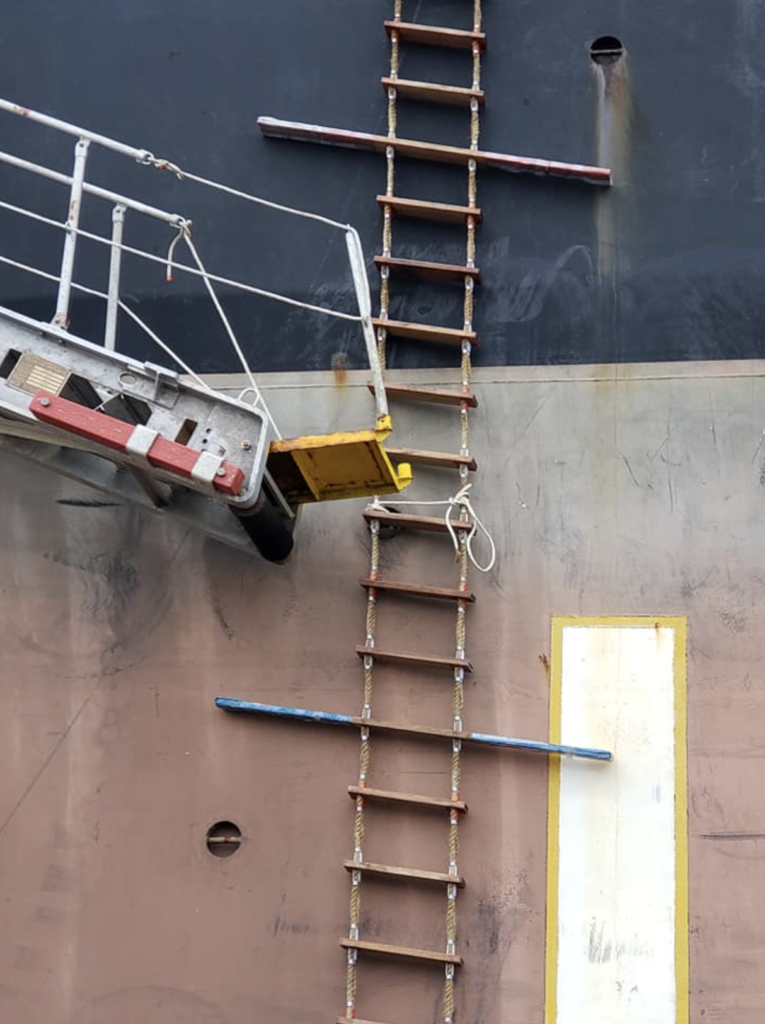
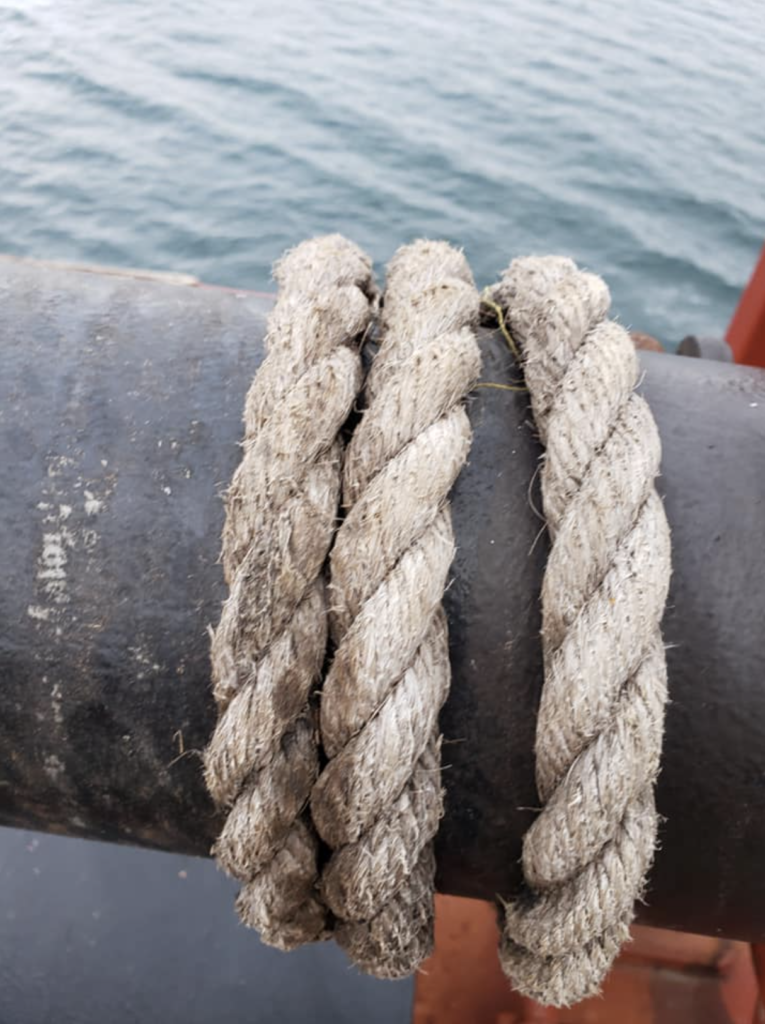
The ladder in question is badly rigged, and appears to be in a very bad state. Much to the surprise of the pilot, he was presented with the following documentation of this pilot ladder by the master of the ship:
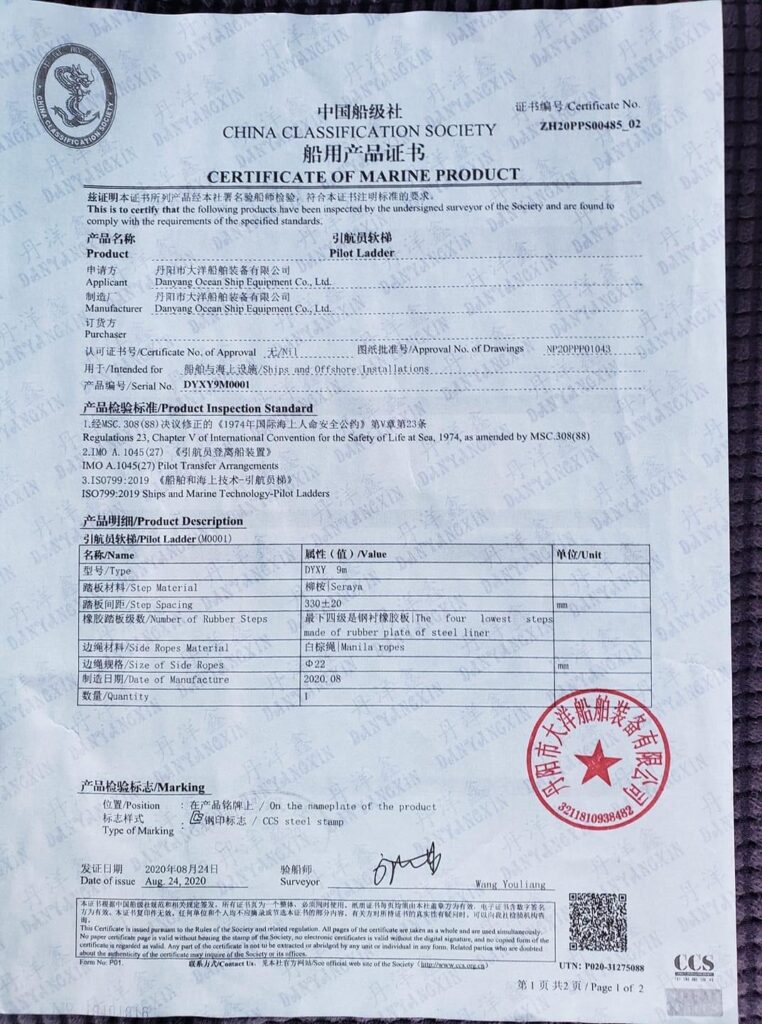
These documents indicate that the pilot ladder in question was only 4 months old at the time. There are references made to SOLAS, IMO 1045 and ISO 799-1:2019. Also there are “official” stamps by the China Classification Society (CCS) on these documents.
In a similar case in 2019, the Australian Marine Pilots Institute (AMPI) asked CCS for a copy of a real (Pilot Ladder) Certificate and they were presented with this document:
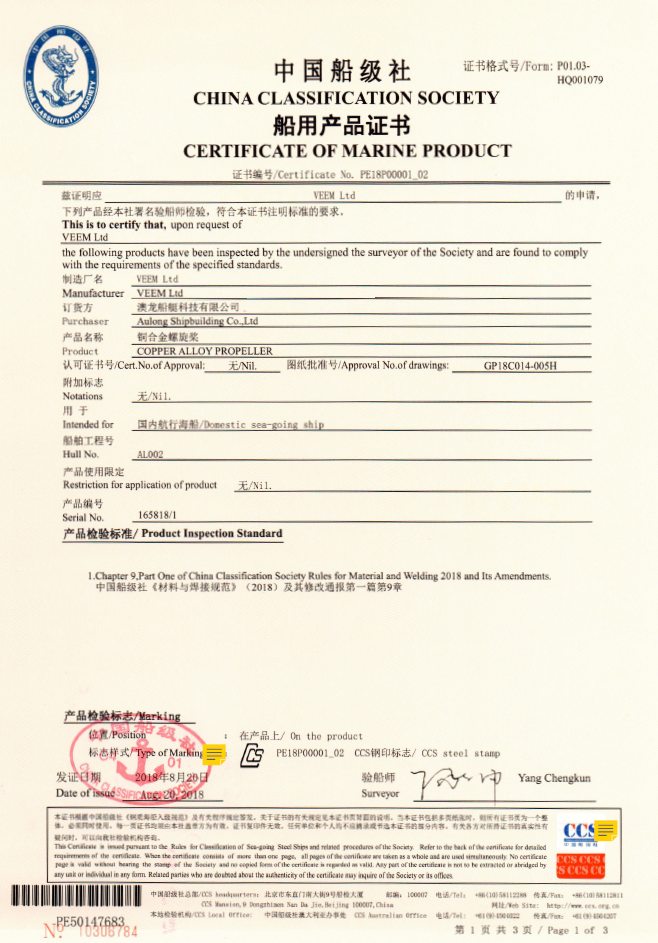
The format of this certificate shows that the presented “Certificate of marine Product” onboard was probably a fake certificate, issued with a very old, used or second-hand pilot ladder.
The EU Marine Equipment Directive (MED), what does it mean?

On many pilot ladders the sign of a small steering wheel is depicted in the certificate and on the pilot ladder as well. What does that mean? The simple answer is: The steering wheel is the symbol of compliance with the EU Marine Equipment Directive. But there is much more to that.
In September 2016, the parliament of the European Union adopted Marine Equipment Directive (MED) 2014/90/EU. The aim of this MED is to set regulations on the standards of marine equipment onboard of EU ships. The scope of the directive is (1) SOLAS 1974: (Life-saving appliances/navigation equipment/radio equipment) and (2) MARPOL 1973: (Marine pollution COLREGS 1972: Prevention of collisions). Since pilot ladders are part of the SOLAS equipment onboard of ships, they are part of this directive as well.
The Marine Equipment Directive 2014/90/EU was then turned into an EU Regulation: Since September 2020, the design, construction, performance requirements and testing standards for marine equipment onboard EU ships are governed by EU Annex to Commission Implementing Regulation (EU) 2020/1170, based directly on the above-mentioned directive.
In section MED 4.49 of the above regulation, under ” Navigation Equipment” the following table is noted:

Table 1: Design-, construction- and performance requirements and testing standards for pilot ladders ; (Source: COMMISSION IMPLEMENTING REGULATION (EU) 2020/1170)
From table 1 the following can be concluded: Pilot ladders on all EU ships must comply with:
- For type-approval:
- Solas 74 Reg V/23 (Safety of navigation) and
- X/3 (Safety measures for high-speed craft)
- For performance requirements:
- SOLAS 74 Reg. V/23,
- IMO Res. A.1045(27), (i.e. the Imo Guidelines)
- IMO MSC/Circ.1428, (i.e. the Wheelhouse poster)
- Testing Standards:
- IMO Res. A.1045(27), as amended
- ISO 799: 2004 (last placing oboard 12.8.2023; e.i. first installation of the equipment in its functional position or stowing in its functional position on board an EU ship) or
- ISO 799-1: 2019 (first placing on the market after 12.8.2020)
- Various modules of conformity assessment. (Column 6)
In other words, for EU ships, not only SOLAS V (23), but also IMO 1045 (27), the wheelhouse poster and the industry standard ISO 799 (either 2004 or 2019) are mandatory.
A case of MED fraud, forgery?
The MED approval is not mandatory for all pilot ladders, but it is for pilot ladders on EU flagged ships. When used, and in order to check the validity of the pilot ladder certificate, one can refer to the NOTIFIED EU BODIES NANDO Register . In this register, all EU Notified bodies are listed which are accredited to carry out MED certification. Below is a fragment of a pilot ladder certificate that was discovered recently. The Steering wheel is shown, as well as the ID of the EU Notified body (0849). All seems in order, this pilot ladders seems to be certified according to the EU regulations.
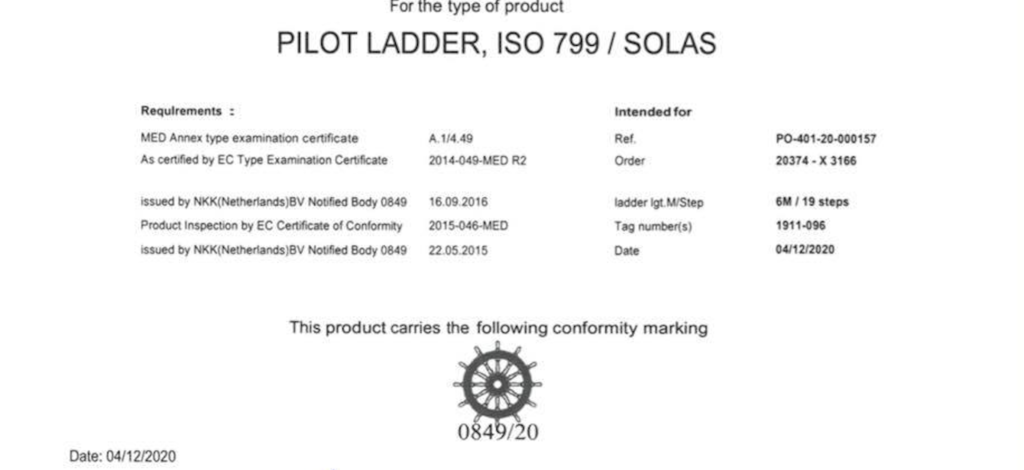
When checking on the NOTIFIED EU BODIES NANDO Register however, the following was discovered: Notified Body number 0849 refers to NKK Netherlands BV. in Barendrecht, The Netherlands. This is a totally legitimate and well known firm. The EU Notified body register shows that this company is not accredited to certify “Navigation Equipment” under which pilot ladders are listed in the EU MED-regulations: ( Column 1 : ” Product family, …).

It appears that the manufacturer of the ladder has deliberately misused the MED logo and the name and reputation of the notified body to give the certificate more value. This could indicate fraud or forgery.
Reference:
LR Marine Equipment Directive home page
COMMISSION IMPLEMENTING REGULATION (EU) 2020/1170
DIRECTIVE 2014/90/EU OF THE EUROPEAN PARLIAMENT AND OF THE COUNCIL
